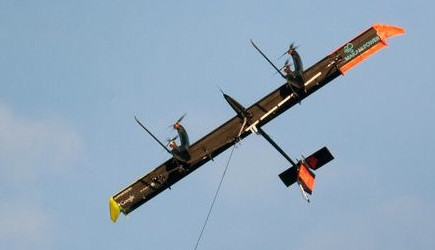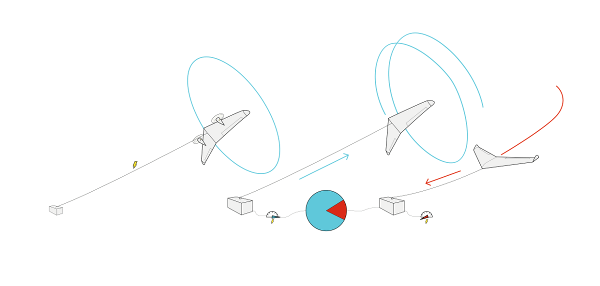The Trillion Dollar Drone
June 24, 2015
on
on

Drones will eventually be “as ubiquitous as pigeons”, London-based futurist Liam Young recently predicted. They are omnipresent already. Only 5 years ago drones belonged to the realm of the military, unaffordable for anyone else. Today, they are for hobbyists and even kids. Drones arrived in our lives and conquered the extreme ends of the market for technical goods. They proved to provide the best value for both, defense budgets and pocket money. Now the race is on to fill the gap in the middle: startups, corporates and analysts try to find the most promising commercial applications for drones.
That is quite a challenge since drones can be used for a surprising variety of tasks. Much media attention was paid to Amazons’, Google’s and DHL’s announcement of using delivery drones. Others see the future for drones in surveillance, detecting fires, cracks in pipelines or illegal wood logging. They can also monitor farmland in detail for precision farming. Or communication: autonomous solar powered drones can be used to hover at high altitude over an area for months to provide wireless communication similar to a satellite. Facebook and Google have invested in startup companies in this field. But there are other disruptive uses for drone technology which the current debate is largely unaware of.
Take the story of Miles Loyd. In the energy crises of the late 1970s Miles Loyd worked as an engineer at Lawrence Livermore National Laboratory. He attempted to build the best wind generator imaginable.
 Loyd’s Formula: P = power; CL = coefficient of lift; CD = coefficient of drag; ρa = air density; A = wing area; V = wind speed
Loyd’s Formula: P = power; CL = coefficient of lift; CD = coefficient of drag; ρa = air density; A = wing area; V = wind speed
He had the radical idea of building it without a tower, only using a flying wing connected to the ground by a tether, much like a kite. He calculated the expected energy output of his “flying wind generator”. Based on the formula he first established – today known as Loyd’s Formula – he found that a wing with the size, weight and aerodynamics of a standard plane wing of the 1970s could produce 6.7 MW of power. Even larger wings with an output of 45 MW seemed feasible. To put this into perspective: even today, 35 years later, the average wind turbine is still below 3 MW and the largest existing prototype has 8 MW. Loyd obtained a patent and published an article on this new technology.
And here the story ends.
He could not convince investors to finance his flying wind generator, because he had no solution for one problem: how to control the flying wing without a pilot?
Today, we have a technology that lets us control flying objects without a pilot. It is called: drones. If we can apply this new technology to Loyd’s old formula we can build a new type of drone: the wind drone.
How exactly does a wind drone work? There is a great resemblance to kite surfers. Kite surfers use a kite and a tether to pull a surfer through the water. The same mechanism can be used to generate electricity. The tethered kite or wing is connected to a drum and a generator on the ground and the tether is wound around the drum. The wing tears at the tether and turns the drum to generate electricity. Once the tether is fully unwound, the wing nosedives and the tether is quickly reeled in. Then the cycle starts again. This up-and-down motion inspired the name “yo-yo” type wind drone.
Google X, overseen by Sergey Brin, is working on a different wind drone in its Makani project. Google’s approach is to use little propellers (mini wind turbines) and generators directly mounted on the wing where they produce electricity. An electric cable is woven into the tether and transfers the electricity to the ground. In 2013 Makani presented a working prototype. They already built their first scaled up product with 600 kW output and announced that it will fly in 2015.

Google will be the first team to show a wind drone with power outputs comparable to today’s wind turbines. But they are not the only ones who have realized that drone technology is ripe to take on Loyd’s formula. Companies including 3M, ABB, Alstom, E.ON, Honeywell, Shell, Statkraft and Softbank have conducted research on wind drones and/or financed one of the dozens of airborne wind energy startups worldwide. Some of the prototypes use soft wings resembling a surf kite or a paraglider, others use hard wings like the wing of an airplane. The designs also differ in many other details. A dominant design has not yet emerged. But irrespective of their final design, wind drones promise to have three characteristics that should turn them into one of the most attractive commercial drone applications. As will be shown in the following they should disrupt their market, they should be amongst the first autonomous drone applications to be market ready and they should have the largest market of all drone applications.
Today, wind energy is produced by wind turbines and wind drones will have to offer significant advantages over turbines for this to change. Airborne wind energy companies claim that wind drones can be built at half the price of wind turbines. In addition, they claim that downtimes for wind drones will be significantly lower and wind drones therefore produce twice as much energy with the same rated power. According to their calculations energy from wind drones could therefore be available at just one quarter of the price of energy produced by wind turbines. But are such claims realistic?

Can you manufacture wind drones more cheaply than wind turbines? The capital costs of a wind turbine which make up the bulk of the total costs of wind energy are the following [1]:
The structural elements, the tower, the blades, the foundation and the rotor hub make up half of the total capital costs of wind turbines. Material requirements are extremely high: Up to 700 tons of steel for the tower [2], another 100 tons of steel for the rotor hub, up to 100 tons of glass-fiber reinforced plastic for the blades, and up to 4000 tons of concrete for the foundation.
That is quite a challenge since drones can be used for a surprising variety of tasks. Much media attention was paid to Amazons’, Google’s and DHL’s announcement of using delivery drones. Others see the future for drones in surveillance, detecting fires, cracks in pipelines or illegal wood logging. They can also monitor farmland in detail for precision farming. Or communication: autonomous solar powered drones can be used to hover at high altitude over an area for months to provide wireless communication similar to a satellite. Facebook and Google have invested in startup companies in this field. But there are other disruptive uses for drone technology which the current debate is largely unaware of.
Take the story of Miles Loyd. In the energy crises of the late 1970s Miles Loyd worked as an engineer at Lawrence Livermore National Laboratory. He attempted to build the best wind generator imaginable.

He had the radical idea of building it without a tower, only using a flying wing connected to the ground by a tether, much like a kite. He calculated the expected energy output of his “flying wind generator”. Based on the formula he first established – today known as Loyd’s Formula – he found that a wing with the size, weight and aerodynamics of a standard plane wing of the 1970s could produce 6.7 MW of power. Even larger wings with an output of 45 MW seemed feasible. To put this into perspective: even today, 35 years later, the average wind turbine is still below 3 MW and the largest existing prototype has 8 MW. Loyd obtained a patent and published an article on this new technology.
And here the story ends.
He could not convince investors to finance his flying wind generator, because he had no solution for one problem: how to control the flying wing without a pilot?
Today, we have a technology that lets us control flying objects without a pilot. It is called: drones. If we can apply this new technology to Loyd’s old formula we can build a new type of drone: the wind drone.
Wind Drone Technology
How exactly does a wind drone work? There is a great resemblance to kite surfers. Kite surfers use a kite and a tether to pull a surfer through the water. The same mechanism can be used to generate electricity. The tethered kite or wing is connected to a drum and a generator on the ground and the tether is wound around the drum. The wing tears at the tether and turns the drum to generate electricity. Once the tether is fully unwound, the wing nosedives and the tether is quickly reeled in. Then the cycle starts again. This up-and-down motion inspired the name “yo-yo” type wind drone.
Google X, overseen by Sergey Brin, is working on a different wind drone in its Makani project. Google’s approach is to use little propellers (mini wind turbines) and generators directly mounted on the wing where they produce electricity. An electric cable is woven into the tether and transfers the electricity to the ground. In 2013 Makani presented a working prototype. They already built their first scaled up product with 600 kW output and announced that it will fly in 2015.

Google will be the first team to show a wind drone with power outputs comparable to today’s wind turbines. But they are not the only ones who have realized that drone technology is ripe to take on Loyd’s formula. Companies including 3M, ABB, Alstom, E.ON, Honeywell, Shell, Statkraft and Softbank have conducted research on wind drones and/or financed one of the dozens of airborne wind energy startups worldwide. Some of the prototypes use soft wings resembling a surf kite or a paraglider, others use hard wings like the wing of an airplane. The designs also differ in many other details. A dominant design has not yet emerged. But irrespective of their final design, wind drones promise to have three characteristics that should turn them into one of the most attractive commercial drone applications. As will be shown in the following they should disrupt their market, they should be amongst the first autonomous drone applications to be market ready and they should have the largest market of all drone applications.
Disrupting the Market
Today, wind energy is produced by wind turbines and wind drones will have to offer significant advantages over turbines for this to change. Airborne wind energy companies claim that wind drones can be built at half the price of wind turbines. In addition, they claim that downtimes for wind drones will be significantly lower and wind drones therefore produce twice as much energy with the same rated power. According to their calculations energy from wind drones could therefore be available at just one quarter of the price of energy produced by wind turbines. But are such claims realistic?

Can you manufacture wind drones more cheaply than wind turbines? The capital costs of a wind turbine which make up the bulk of the total costs of wind energy are the following [1]:
The structural elements, the tower, the blades, the foundation and the rotor hub make up half of the total capital costs of wind turbines. Material requirements are extremely high: Up to 700 tons of steel for the tower [2], another 100 tons of steel for the rotor hub, up to 100 tons of glass-fiber reinforced plastic for the blades, and up to 4000 tons of concrete for the foundation.
Read full article
Hide full article



Discussion (0 comments)